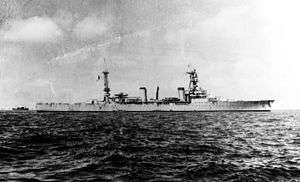French cruiser Duquesne (1925)
Duquesne was a French heavy cruiser and name ship of her class that served during World War II.
 Duquesne in 1943 | |
| History | |
|---|---|
| Name: | Duquesne |
| Namesake: | Abraham Duquesne |
| Builder: | Brest Dock Yard |
| Laid down: | 30 October 1924 |
| Launched: | 17 December 1925 |
| Commissioned: | 6 December 1928 |
| Fate: | Condemned 2 July 1955 |
| General characteristics | |
| Class and type: | Duquesne-class cruiser |
| Displacement: |
|
| Length: | 191 m (627 ft) overall |
| Beam: | 19 m (62 ft) |
| Draught: | 6.32 m (20.7 ft) |
| Propulsion: | 4-shaft Rateau-Bretagne single-reduction geared turbines, 9 Guyot boilers, 120,000 shp (89,000 kW) |
| Speed: | 33.75 knots (62.51 km/h) |
| Range: | 4,500 nautical miles (8,300 km) at 15 knots (28 km/h) |
| Complement: | 605 |
| Armament: |
|
| Armour: |
|
| Aircraft carried: | 2 GL-812 (superseded by GL-832 then Loire-Nieuport 130, 1 catapult |
Design and description
The design of the Duquesne class was derived from an enlarged version of the Duguay-Trouin-class light cruiser armed with 203-millimetre (8 in) guns. The ships had an overall length of 191 meters (626 ft 8 in), a beam of 19 meters (62 ft 4 in), and a draft of 6.45 meters (21 ft 2 in). They displaced 10,160 metric tons (10,000 long tons) at standard load and 12,435 t (12,239 long tons) at deep load. Their crew normally consisted of 605 men and increased by 32 when serving as flagships.[1]
Service history
At the outbreak of the Second World War, Duquesne was part of the Force X, under Vice Admiral Godfroy. In January 1940, she took part in the hunt for the German cruiser Admiral Graf Spee, and later returned to Alexandria. On 3 July, the French squadron under Admiral René-Emile Godfroy in Alexandria was blockaded by the British executing Operation Catapult ; Godfroy avoided destruction by negotiating to disarm his fleet and stay in port until the end of the war. In June 1943, Duquesne was incorporated in the Free French Naval Forces and served in the Atlantic.
She undertook a refit in 1945, and served in French Indochina until 1947.
References
- Jordan & Moulin, p. 44
Bibliography
- Jordan, John & Moulin, Jean (2013). French Cruisers 1922–1956. Barnsley, UK: Seaforth Publishing. ISBN 978-1-84832-133-5.